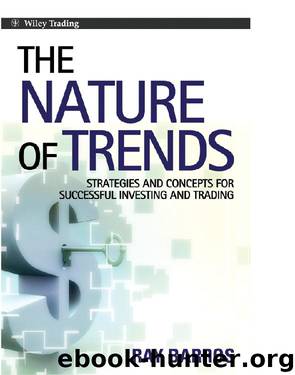The Nature of Trends by Ray Barros

Author:Ray Barros
Language: eng
Format: epub
ISBN: 9781118179505
Publisher: John Wiley & Sons
ENTRY
Zones
Zones are areas of support (for long trades) or areas of resistance (for short trades). In essence, they represent the areas where I am confident a trade will prove successful. After trend identification, this is the most important focus of my analysis.
The tools I use to determine zones are:
the statistical time and price windows;
MIDAS; and
Fibonacci ratios.
Statistical Time and Price Windows
This isn’t the place for a full exposition of my views on the nature of statistics and probability theory. But I will say this: I don’t follow textbook ideas. My approach is heavily influenced by my understanding of the current state of Complexity Theory and my own experiences in trading.
In this section, I shall present a brief summary of the methodology I use. The important thing is that it works for me—that is, it improves my net bottom line.
I have two ways of calculating the statistical time and price windows. I will explain first what I call the “quick and dirty way.”
Take a sample of at least 15 impulse moves. [Theoretically, we should take at least 40 readings, but in my experience most traders are unwilling to calculate 15 readings, let alone 40. In any event, most of the time, 15 readings will produce satisfactory results. The samples include the price ranges and the time ranges between impulse swings.
Calculate the mean and standard deviation of the sample.
Delete all the outliers—that is, all readings beyond mean +3 standard deviations and mean −3 standard deviations.
From the remaining data, recalculate the mean and standard deviation.
The values thus obtained allow me to define five conditions: 1. A normal reading, which for me means that there is a 50:50 chance that the impulse move will continue (mean +1 standard deviation to mean −0.5 standard deviation).
2. A moderately subnormal reading, which for me means that it’s unlikely that the impulse move will terminate in this time frame. I look for opportunities to add to my positions on first lower time-frame retracements (mean −1 standard deviation).
3. A moderately abnormal reading, which for me means there is some probability that the impulse move will shortly be coming to an end (mean +2 standard deviations). With this reading, I tend to tighten my trailing stops, and I’m reluctant to add to new positions.
4. A significantly subnormal reading, which for me means that it is exceedingly unlikely that the impulse move will terminate in this time frame (mean −1.5 standard deviation). I aggressively look for opportunities to add to my positions in the second lower time frame.
5. A significantly abnormal reading, which for me means that it is exceedingly likely that the impulse move will shortly be coming to an end (mean +3 standard deviation). With this reading, I’m looking for opportunities to liquidate my positions.
Download
This site does not store any files on its server. We only index and link to content provided by other sites. Please contact the content providers to delete copyright contents if any and email us, we'll remove relevant links or contents immediately.
| Analysis & Strategy | Bonds |
| Commodities | Derivatives |
| Futures | Introduction |
| Mutual Funds | Online Trading |
| Options | Portfolio Management |
| Real Estate | Stocks |
Rich Dad Poor Dad by Robert T. Kiyosaki(6324)
Pioneering Portfolio Management by David F. Swensen(6175)
How To Win Friends and Influence People by Dale Carnegie(4410)
The Money Culture by Michael Lewis(4033)
The Dhandho Investor by Mohnish Pabrai(3642)
The Wisdom of Finance by Mihir Desai(3612)
Liar's Poker by Michael Lewis(3330)
Fooled by Randomness: The Hidden Role of Chance in Life and in the Markets by Nassim Nicholas Taleb(2981)
The ONE Thing by Gary Keller(2976)
The Intelligent Investor by Benjamin Graham Jason Zweig(2972)
Mastering Bitcoin: Programming the Open Blockchain by Andreas M. Antonopoulos(2956)
Rich Dad Poor Dad: What The Rich Teach Their Kids About Money - That The Poor And Middle Class Do Not! by Robert T. Kiyosaki(2882)
Investing For Dummies by Eric Tyson(2840)
How to Win Friends and Influence People by Dale Carnegie(2833)
How to Day Trade for a Living: Tools, Tactics, Money Management, Discipline and Trading Psychology by Andrew Aziz(2833)
Market Wizards by Jack D. Schwager(2595)
Zero Hour by Harry S. Dent Jr. & Andrew Pancholi(2569)
How to Pay Zero Taxes, 2018 by Jeff A. Schnepper(2560)
The Psychology of Money by Morgan Housel(2469)
